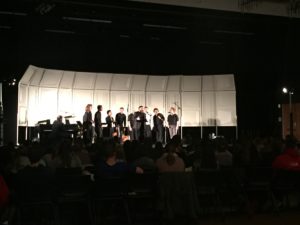Keeping up with tradition, but changing with the new space
I regularly encounter reoccurring events on campus; yearly activities that different departments host to raise funds, celebrate their achievements, or to just have fun. Working with a variety of people, trying to meet the needs of their event, can offer up quite the challenge sometimes. Several of these organizations have, in their own ways, established traditions for their events: how the room is set up, the position of the lighting, the stage setup, methods of projection, staging options, or other fine details. With a new building, many of these traditions need alterations due to the many changes within the new space and its different technology – this throws both customers and staff into a new learning curve.
 In my time in this position, many of these recurring events have become familiar and normal. In the past, all that’s been required is a quick check-in to see if there are any changes, confirm the date, and move on. This semester has been extremely different. It has been important to not take the norms of the past for granted. As a service provider with a new facility, it has been important to take a moment to consider all the events and the changes the venue’s offering and then adjust accordingly to all the changes. It has become important to slow down, to reconnect with everyone, both staff and customers, to make sure they understand the changes that have occurred and how they might affect their events.
In my time in this position, many of these recurring events have become familiar and normal. In the past, all that’s been required is a quick check-in to see if there are any changes, confirm the date, and move on. This semester has been extremely different. It has been important to not take the norms of the past for granted. As a service provider with a new facility, it has been important to take a moment to consider all the events and the changes the venue’s offering and then adjust accordingly to all the changes. It has become important to slow down, to reconnect with everyone, both staff and customers, to make sure they understand the changes that have occurred and how they might affect their events.
For instance, the new facility has improved customer-controlled projection, which accommodates most customers’ desire to be able to run individual PowerPoints without the added cost of having staff there to help. However, there is no professional video switching at the moment so some groups have to rethink their presentation to have seamless viewing of PowerPoints and DVDs. To work through these changes it has been important to provide customer training on the newly installed technology, taking into consideration how this challenges any of their long-standing practices. The more of these challenges you can identify and work in advance, the better; customers need time to learn all the new stuff and to make adjustments.
Another example is the lighting in the venue. Previously, we had over thirty lights, now we have eight (at least until we have worked through some budgeting and contracting issues). Eight lights by no means produce the coverage needed for the stage, let alone the traditional look dance groups strive for. Connecting with each dance group is important to explain the limitations of the space, including offering them the best options possible to support their event, so they can plan accordingly.
The biggest hurdle within the venue at the moment is the size and shape of the room. It is such a change from the old space that everyone that uses the venue has to take the time to really learn the space and hear the differences. Even with the assistance of technology and some acoustical treatment, there is still a significant slap-back off the back wall which reaches the front of the stage just in time to muddle in with the monitor sound. There is some acoustic treatment but it’s not enough, and it is going to take time to purchase and install more. In the meantime, we have to strategically plan to assist groups, warning them about the slap-back, and trying new setups to alleviate some of the effects until improvements are possible.
Overall, the venue is still a work in progress, and it will take time to meet all of our customers’ desires. There seems to be an idea that this change was going to make everything perfect, solving all the problems of the past, but that has not been the case so it is important to connect with everyone to work together to create some amazing events.
In my case, the new building brought the need to look at old practices and make new ones. It has highlighted how easy it is to get caught in the norms or traditions of regular events. Sometimes it is important to reconnect and truly talk through details, explaining the new opportunities a venue or equipment has to offer. This way, as service providers, we can meet the resources and skills to create even more spectacular events.
